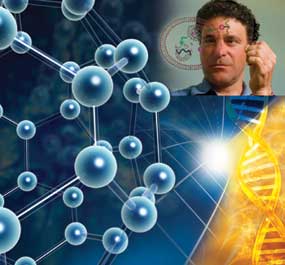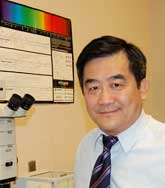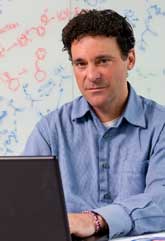
Engineering Molecules:
Tiny Solutions for Big Problems
Molecular engineering is an emerging discipline that is generating excitement and questions. How will it shape UW Engineering? How will it help solve tough problems in energy, health care, and other fields?
Imagine giving doctors the tools to pinpoint the exact location of disease molecules inside your cells. Imagine curing disease by sending safe biologic agents on a direct attack against these targets.
The power to do so is coming through the work of molecular engineers. They are capitalizing on a decade of advances in nanotechnology to design new molecules and systems of molecules that may not exist in nature. With great precision, they manipulate structure and function, often one molecule at a time, an exceedingly difficult challenge. They are making breakthroughs via advanced synthesis and characterization tools such as nanolithography.
In the next ten years, complex molecular nanosystems and devices will allow scientists to penetrate ever deeper into molecular and atomic processes. UW Engineering is leading the way, particularly in medical and energy research, as described in the sidebar examples.
Molecular engineering, MolE for short, also will develop self-repairing materials for a wide range of equipment and construction uses, as well as for electronic, photonic, and optical consumer goods. The environment will benefit too. MolE solutions will help us address global warming, monitor environmental pollutants, and safeguard food, water, and other resources.
MolE’s Universe
Molecular engineering is highly interdisciplinary, tapping expertise in engineering, chemistry, biology, the medical sciences and computation/modeling. Dozens of UW faculty members, many international leaders in their fields, are helping to define what it means to be molecular engineers. Engineering faculty members have secured major federal grants and work in teams that also include experts in the basic sciences, researchers at Fred Hutchinson Cancer Research Center, and representatives from the high-tech sector.
A new UW molecular engineering building will further the work. The $120-million, 160,000-square-foot facility... [will feature] large laboratories, faculty offices, conference rooms, and space for graduate students.
“We envision UW Engineering, the University, and the Puget Sound region leading molecular engineering,” Dean Matt O’Donnell said. “The UW ranks second among all universities in federal research funding, and the Puget Sound region is a magnet for biotech and high-tech innovation.”
A new UW molecular engineering building will further the work. The $120-million, 160,000-square-foot facility, to be constructed in two phases, features large laboratories, faculty offices, conference rooms, and space for graduate students. Phase I funding includes state and internal UW funds, as well as debt and private gifts.
“The MolE building is a job creator, so it fits well with economic stimulus goals,” O’Donnell said. “Innovations that emerge from its laboratories will provide an economic boost for the region via spin-off technologies and startup companies. If the funding comes through, we plan to break ground in late summer.”
“We want the UW to be at the forefront of MolE innovation, attracting both the best students and the best faculty,” O’Donnell said.
Energy Challenge: Design Efficient and Cheap Organic Solar Cells
 Imagine turning an entire outside wall of your home into a solar collector or
powering your cell phone with light-enhanced batteries. Materials Science & Engineering Professor Alex Jen and his team are developing technologies that help meet energy needs with less environmental impact.
Imagine turning an entire outside wall of your home into a solar collector or
powering your cell phone with light-enhanced batteries. Materials Science & Engineering Professor Alex Jen and his team are developing technologies that help meet energy needs with less environmental impact.
Conventional solar panels made of silicon are expensive, and the energy generated costs five to six times more per watt than fossil fuels. Jen’s team aims to lower costs by combining organic and inorganic nanostructures into photovoltaic devices. These thin polymer solar cells can be incorporated into flexible plastic films for walls or electronic devices. Semi-transparent versions could be used for solar windows.
Polymer solar cells have reached energy conversion levels of 6 percent, still below the 20 percent efficiency of silicon-based cells. Once efficiency reaches 10 percent, they will be cost-effective for large-scale manufacturing. “The possibilities are exciting. We want to offer low-cost solar cells to every home,” Jen said.
The U.S. Departments of Energy and Defense have invested $2 million in this research. Also, UW Tech Transfer is helping Jen launch Soluxra, a startup company.
MolE in Energy Delivery
|
Tapping renewable resources, reducing energy waste and pollution Solar Power: Advanced solar cells and systems will produce efficient, cost-effective energy for many applications. Smart Materials: Reconfigurable materials will reduce energy waste by improving energy generation, storage, and transport. Biomass Fuel: New molecular processes will turn logging wastes and algae into inexpensive, widely used renewable energy resources for transportation. |
 A prototype polymer solar cell powers a calculator in the Jen lab. |
Health Challenge: Deliver Sharpshooter Drugs into Cells
 Bioengineering Professor Pat Stayton and his team want to treat disease at its most fundamental level. They devise ways to transport
therapeutic proteins into cells while avoiding toxic side effects caused by many small-molecule drugs.
Bioengineering Professor Pat Stayton and his team want to treat disease at its most fundamental level. They devise ways to transport
therapeutic proteins into cells while avoiding toxic side effects caused by many small-molecule drugs.
“Fewer new small-molecule drugs are entering the pharmaceutical pipeline, and the industry is eager to develop safer macromolecule biologics to treat cancer and inflammatory diseases,” Stayton said. “It is one of the hottest areas in biotechnology.”
His research team, working with fellow Bioengineering Professor Allan Hoffman, is developing drug delivery systems — innocuous synthetic polymers that will mimic the ways pathogens cross cell membranes. Once inside, this “smart” delivery tube would head to a precise target and release a biologic drug, such as a gene-silencing RNA, to knock out disease.
Stayton recently received a four-year, $7.2-million grant from the Washington Life Sciences Fund to create the Center for the Intracellular Delivery of Biologics. UW engineers, pharmaceutical scientists, and clinical researchers will team up to develop these intracellular sharpshooters. Stayton and Hoffman also recently formed a company, PhaseRX, to develop RNA-based drugs.
MolE in Medicine
|
Transforming mass medicine into precise, personalized diagnostics and therapeutics Earlier Diagnosis: Molecular imaging tools will help lead to preventive techniques that also help reduce health care costs. Better Treatments: New drugs working inside cells will treat the most life-threatening diseases with fewer side effects. Care for the Poorest: Portable diagnostic tools that withstand extreme environmental conditions will enable better health care in the poorest and harshest regions of the world. |
 A biotherapeutic “smart” carrier (A) transports a drug into the cell and releases it when it reaches (B), the disease-bearing target endosome. |